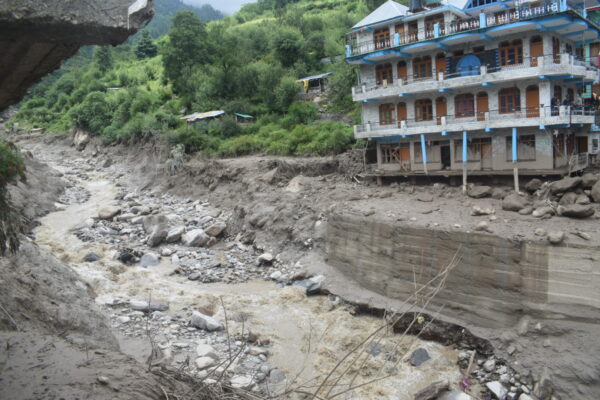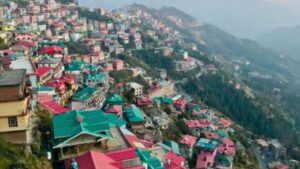Disaster management team leaves for Kashang in Kinnaur district: Team is examining potential threats from natural lakes formed by glaciers in Sangla Kande area

Reckong Peo, July 31: Glacial lakes have posed a major threat to the Himalayan region, due to which the disaster management team has left for Kashang in Kinnaur district. The team is examining the potential threats from the natural lakes formed by the glaciers in the Sangla Kande area. SP Kinnaur Abhishek S flagged off the team on Tuesday. The team will first inspect a glacial lake at Kashang, at an altitude of about 4300 m, and assess the potential threats in future in case of a lake burst. Their findings will be compiled in a report for the Kinnaur administration.
The initiative comes after large lakes were formed in Sangla Kande, including Kashang, due to glaciers falling last winter. The Kinnaur administration is closely monitoring these lakes to mitigate potential threats and reduce the risk to life and property.
Historical context of glacial lake outburst floods (GLOFs)-
Glacial lakes, formed by retreating glaciers, are dammed by moraines – accumulations of rock, boulders and debris. When these lakes overflow or their dams are breached, GLOFs can occur, causing considerable damage downstream. The Indian Himalayan region is particularly vulnerable, with numerous incidents highlighting the destructive potential of these events.
For example, the 2013 Kedarnath tragedy in Uttarakhand, triggered by a GLOF from the Chorabari glacier, resulted in over 5,000 deaths. Similarly, the 1981 Kinnaur Valley floods in Himachal Pradesh caused widespread devastation. The increasing frequency and intensity of these events is attributed to climate change, which accelerates glacier melt and the formation of lakes.
Natural lakes in the Tibet hills burst in the years 2000 and 2005, causing flooding in the Sutlej and Spiti rivers. The excessive water flow caused loss of many lives and heavy damage to government and non-government properties in riverine areas such as Kinnaur, Rampur, Tattapani and Bilaspur. The floods also caused collapse of many bridges, leaving Spiti, including Kinnaur, cut off by road for several months.
Factors contributing to GLOFs-
GLOFs can be triggered by a number of factors, including heavy rainfall, rapid snow melt, landslides and seismic activity. Unstable moraine dams, often made of loose, unconsolidated materials, are particularly susceptible to rupture under these conditions.
Climate change plays a key role in increasing the frequency of GLOFs. As global temperatures rise, glaciers are melting faster, creating larger and more numerous glacial lakes. This not only increases the volume of water present in these lakes, but also makes the moraine dams less stable, increasing the risk of catastrophic bursts.
Mitigation efforts and future precautions-
Recognizing the growing threat, the Government of India has initiated several measures to deal with GLOF. These include setting up high-altitude meteorological and discharge stations equipped with advanced technologies such as synthetic aperture radar (SAR) for early detection of changes in glacial lakes. SAR technology allows continuous monitoring of glacier dynamics and lake levels, providing critical data for early warning systems.
Collaborative efforts among various agencies aim to enhance data sharing and improve risk analysis and response strategies. The National Disaster Management Authority (NDMA) has been actively involved in creating comprehensive GLOF risk management plans, including mapping vulnerable areas, setting up early warning systems, and conducting community awareness programs.
Additionally, the Defense Geo-informatics Research Establishment (DGRE) is working to expand the network of automated weather stations in vulnerable states, including Himachal Pradesh and Uttarakhand, to predict avalanches and landslides. These efforts are part of a broader strategy to develop effective GLOF risk management and early warning systems.
Community Participation and Preparedness-
Local communities play a vital role in disaster preparedness and response. The Himachal Pradesh government is conducting training programs to educate residents about the risks associated with glacial lakes and the importance of early evacuation in case of a potential GLOF. These programs are aimed at building resilience and ensuring that communities are well-prepared to respond to emergencies.
As the Kinnaur Disaster Management Team conducts its crucial investigation, it underscores the urgent need for continuous monitoring and proactive measures to address the risks posed by glacial lakes in the Himalaya. With these hazards increasing due to climate change, coordinated efforts and advanced technological interventions are essential to protect communities and mitigate the impacts of future GLOFs.
Get The Latest News Of Himachal First On Mobile, Click Here To Join Our WhatsApp Group

Continuing the achievement of the journey of effectiveness and credibility of more than 10 years in the career of journalism, as a woman journalist, I am Serving as the founder, promoter and editor of DiaryTimes with the trust and support of all. My credible coverage may not have given a big shape to the numbers, but my journey presents articles that make you aware of the exact and meaningful situations of Himachal’s politics, ground issues related to the public, business, tourism and the difficult geographical conditions of the state and financial awareness. DiaryTimes, full of the experience of my precise editorial expertise, is awakening the flame of credible journalism among all of you, so that the eternal flame of meaningful change can be lit in the life of the people of the state and the atrocities being committed against the people can be brought to the fore, I am motivated for that. If even a small change comes with the power of my journalism and the whole world becomes a witness to that issues, then I will consider myself fortunate.





